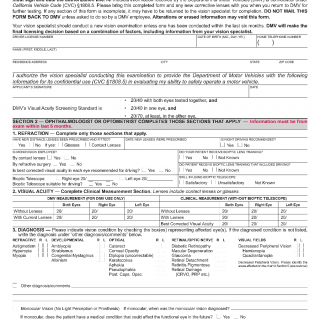Form DL 62. Report of Vision Examination
The Report of Vision Examination (DL 62) form is used by the California Department of Motor Vehicles (DMV) to assess the visual acuity of drivers applying for or renewing their driver's license. The form is designed to ensure that drivers have adequate vision to safely operate a motor vehicle on public roads.
The form consists of two parts: Part A and Part B. Part A is completed by the driver, who must provide their personal information, including their name, date of birth, and driver's license number. They must also answer a series of questions about their vision, including whether they wear corrective lenses and whether they have any medical conditions that may affect their vision.
Part B is completed by a licensed vision specialist, such as an optometrist or ophthalmologist. The vision specialist will conduct a comprehensive eye exam to assess the driver's visual acuity and peripheral vision. They will then complete Part B of the form, which includes their professional information, the results of the eye exam, and any recommendations for corrective lenses or other vision treatments.
The parties involved in the completion of this form are the driver and the licensed vision specialist who performs the eye exam.
When compiling the form, the driver will need to provide their personal information and answer questions about their vision. The licensed vision specialist will need to conduct a comprehensive eye exam and provide the results on the form.
No additional documents need to be attached to the form, but the driver may need to provide proof of corrective lenses or other vision treatments if recommended by the vision specialist.
Application examples include drivers who are applying for or renewing their driver's license and those who have been referred by the DMV for a vision exam due to a previous driving incident.
The benefits of this form include ensuring that drivers have adequate vision to safely operate a motor vehicle, which can help prevent accidents and injuries on public roads. The challenges and risks include the potential for drivers to misrepresent their vision or for vision specialists to provide inaccurate or incomplete information on the form.
Related and alternative forms include the DL 546A, which is used for drivers who are unable to meet the vision standards on the DL 62 form and need to request a medical evaluation from the DMV. Analogues of this form may include similar vision examination forms used by other state DMVs.
The completion of this form affects the future of the participants by ensuring that drivers have adequate vision to safely operate a motor vehicle on public roads. Drivers who do not meet the vision standards may need to seek corrective lenses or other vision treatments before they can legally drive.
The completed form is submitted to the DMV, where it is stored in the driver's record.

